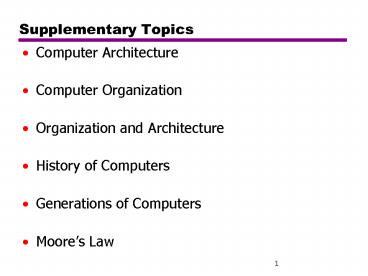Supplementary Topics PowerPoint PPT Presentation
1 / 16
Title: Supplementary Topics
1
Supplementary Topics
- Computer Architecture
- Computer Organization
- Organization and Architecture
- History of Computers
- Generations of Computers
- Moores Law
2
Computer Architecture (1)
- Definition?
- The design of integrated system which provides a
useful tool to the programmer. (Baer) - The study of the structure, behaviour, and
design of computers. (Hayes) - The design of the system specification at a
general or subsystem level. (Abd-Alla) - The art of designing a machine that will be a
pleasure to work with. (Foster)
3
Computer Architecture (2)
- The interface between the hardware and the
lowest level software. (Hennessy and Patterson) - Keyword
- Design
- System
- Structure
- Art Tool Interface
4
Computer Architecture (3)
- Therefore, computer architecture refers to
- Attributes of a system visible to programmers
- Attributes that have a direct impact on the
execution of programs - Attributes
- Instruction set
- Data representation
- I/O mechanisms
- Addressing techniques
5
Computer Organization
- Organization refers to operational units and
their interconnections that realize the
architectural specifications. - Attributes hardware details transparent to
programmers - Control signals
- Computer/peripheral interface
- Memory technology
6
Architecture Organization (1)
- Architecture is attributes visible to programmers
- Organization is how features are implemented
- Example
- Architecture multiply instruction?
- Organization hardware multiply unit or done by
repeated addition? (how is it implemented?) - Example
- IBM/370 architecture
- different models (organizations)
7
Architecture Organization (2)
- Family Concept
- All Intel x86 family share the same basic
architecture - The IBM System/370 family share the same basic
architecture - This gives code compatibility (at least
backwards) - Organization differs between different versions
8
History of Computers (1)
- Pre-mechanical Era
- Abacus (ancient China)
- Mechanical Era (1623 1940s)
- Wilhelm Schickhard (1623)
- Automatically , -, x, ?
- Blaise Pascal (1642)
- Mass produced first working machine (50)
- Only , -
- Gottfried Liebniz (1673)
- Improved on Pascals machine (, -, x, ?)
9
History of Computers (2)
- Mechanical Era (contd)
- Charles Babbage (1822)
- Father of modern computer
- Automatic computation of math tables
- Any math operation
- Punch cards
- Modern structure I/O, storage, ALU
- 1 sec. x 1 min.
- George Boole (1847)
- Mathmatical analysis of logic
10
History of Computers (3)
- Mechanical Era (contd)
- Herman Hollerith (1889)
- Modern day punch card machine
- Tabulating machine company ? predecessor of
- Konard Zuse (1938)
- First working mechanical computer, Z1 (later on
Z2 Z4) - First programmable computer
- Binary floating point machine
- Howard Aiken (1943)
- Harvard Mark I, built by IBM
- Implementation of Babbages machine
IBM
11
History of Computers (4)
- Summary of Mechanical Era
- Contributions
- Reduce calculation time
- Increase accuracy
- Drawback
- Speed limited by moving parts
- Cumbersome
- Expensive
- Unreliable
- Entered the Electronic Era (1945 present)!!
12
von Neumann/Turing
- Stored Program concept
- Main memory storing programs and data
- ALU operating on binary data
- Control unit interpreting instructions from
memory and executing - Input and output equipment operated by control
unit - Princeton Institute for Advanced Studies
- IAS
- Completed 1952 Basis for virtually every machine
designed since then
13
Structure of von Neumann machine
14
Generations of Computer
- First generation Vacuum tube - 1946-1957
- Second generation Transistor - 1958-1964
- Third generation Integrated circuits 1965
1971 - Small scale integration - 1965 on
- Up to 100 devices on a chip
- Medium scale integration - to 1971
- 100-3,000 devices on a chip
- Semiconductor memory (1970)
- Microprocessor (1971)
15
Generations of Computer
- Fourth generation Large scale integration (LSI)
- 1971-1977 - 3,000 - 100,000 devices on a chip
- Intel 8080 first general-purpose microprocessor
(1974) - Fifth generation 1978 present
- Very large scale integration (VLSI) - 1978 to
date - 100,000 - 100,000,000 devices on a chip
- Ultra large scale integration (ULSI)
- Over 100,000,000 devices on a chip
- GSI ??
16
Moores Law
- Increased density of components on chip
- Number of transistors on a chip will double every
year - Since 1970s development has slowed a little
- Number of transistors doubles every 18 months
- Cost of a chip has remained almost unchanged
- Higher packing density means shorter electrical
paths, giving higher performance - Smaller size gives
- increased flexibility
- Reduced power and
- cooling requirements
- Fewer interconnections
- increases reliability

